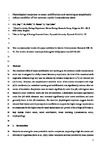Physiological responses to ocean acidification and warming synergistically reduce condition of the common cockle Cerastoderma edule
| dc.contributor.author | Ong, EZ | |
| dc.contributor.author | Briffa, Mark | |
| dc.contributor.author | Moens, T | |
| dc.contributor.author | Van Colen, C | |
| dc.date.accessioned | 2017-11-14T09:27:36Z | |
| dc.date.issued | 2017-07-05 | |
| dc.identifier.issn | 0141-1136 | |
| dc.identifier.issn | 1879-0291 | |
| dc.identifier.uri | http://hdl.handle.net/10026.1/10154 | |
| dc.description.abstract |
The combined effect of ocean acidification and warming on the common cockle Cerastoderma edule was investigated in a fully crossed laboratory experiment. Survival of the examined adult organisms remained high and was not affected by elevated temperature (+3 °C) or lowered pH (-0.3 units). However, the morphometric condition index of the cockles incubated under high pCO2 conditions (i.e. combined warming and acidification) was significantly reduced after six weeks of incubation. Respiration rates increased significantly under low pH, with highest rates measured under combined warm and low pH conditions. Calcification decreased significantly under low pH while clearance rates increased significantly under warm conditions and were generally lower in low pH treatments. The observed physiological responses suggest that the reduced food intake under hypercapnia is insufficient to support the higher energy requirements to compensate for the higher costs for basal maintenance and growth in future high pCO2 waters. | |
| dc.format.extent | 38-47 | |
| dc.format.medium | Print-Electronic | |
| dc.language | en | |
| dc.language.iso | en | |
| dc.publisher | Elsevier BV | |
| dc.subject | Future ocean | |
| dc.subject | Ocean acidification | |
| dc.subject | Ocean warming | |
| dc.subject | Cerastoderma edule | |
| dc.subject | Ecophysiology | |
| dc.title | Physiological responses to ocean acidification and warming synergistically reduce condition of the common cockle Cerastoderma edule | |
| dc.type | journal-article | |
| dc.type | Journal Article | |
| plymouth.author-url | https://www.webofscience.com/api/gateway?GWVersion=2&SrcApp=PARTNER_APP&SrcAuth=LinksAMR&KeyUT=WOS:000413382600005&DestLinkType=FullRecord&DestApp=ALL_WOS&UsrCustomerID=11bb513d99f797142bcfeffcc58ea008 | |
| plymouth.volume | 130 | |
| plymouth.publication-status | Published | |
| plymouth.journal | Marine Environmental Research | |
| dc.identifier.doi | 10.1016/j.marenvres.2017.07.001 | |
| plymouth.organisational-group | /Plymouth | |
| plymouth.organisational-group | /Plymouth/Faculty of Science and Engineering | |
| plymouth.organisational-group | /Plymouth/Faculty of Science and Engineering/School of Biological and Marine Sciences | |
| plymouth.organisational-group | /Plymouth/REF 2021 Researchers by UoA | |
| plymouth.organisational-group | /Plymouth/REF 2021 Researchers by UoA/UoA04 Psychology, Psychiatry and Neuroscience | |
| plymouth.organisational-group | /Plymouth/Research Groups | |
| plymouth.organisational-group | /Plymouth/Research Groups/Marine Institute | |
| plymouth.organisational-group | /Plymouth/Users by role | |
| plymouth.organisational-group | /Plymouth/Users by role/Academics | |
| plymouth.organisational-group | /Plymouth/Users by role/Researchers in ResearchFish submission | |
| dc.publisher.place | England | |
| dcterms.dateAccepted | 2017-07-03 | |
| dc.rights.embargodate | 2019-7-5 | |
| dc.identifier.eissn | 1879-0291 | |
| dc.rights.embargoperiod | Not known | |
| rioxxterms.versionofrecord | 10.1016/j.marenvres.2017.07.001 | |
| rioxxterms.licenseref.uri | http://www.rioxx.net/licenses/all-rights-reserved | |
| rioxxterms.licenseref.startdate | 2017-07-05 | |
| rioxxterms.type | Journal Article/Review |


